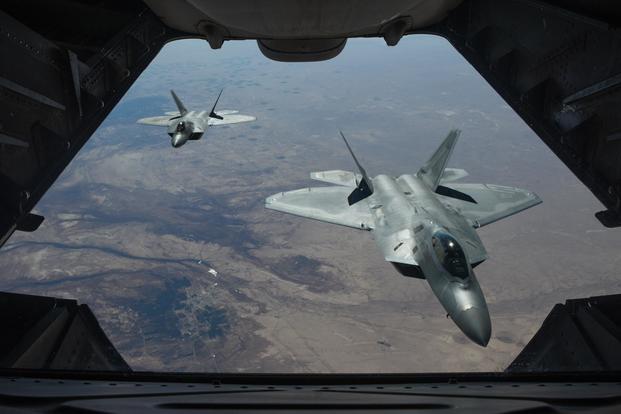As pro-Assad forces attacked Syrian Democratic Forces in Deir el-Zour Province on Wednesday, the U.S. launched significant air and firepower to protect coalition service members working with the SDF in an advise, assist and accompany capacity, defense officials said.
The U.S. sent up the F-22A Raptor advanced stealth fighter, along with drones, to watch as the three-hour battle began.
"At the start of the unprovoked attack on Syrian Democratic Forces and coalition advisers, coalition aircraft, including F-22A Raptors and MQ-9B Reapers, were overhead providing protective overwatch, defensive counter air and [intelligence, surveillance and reconnaissance] support as they have 24/7 throughout the fight to defeat ISIS," Air Forces Central Command spokesman Lt. Col. Damien Pickart told Military.com.
"Following a call for support from Air Force Joint Terminal Attack Controllers, a variety of joint aircraft and ground-based artillery responded in defense of our SDF partners, including F-15E Strike Eagles," he said in a statement Thursday.
Related content:
- General: US Pilots Made the Call to Shoot Down Syrian Aircraft
- US Launches Rare Strike on Syrian Government-Backed Troops
- The F-22 in Syria: Deconflicting, Not Dog-Fighting
"These aircraft released multiple precision-fire munitions and conducted strafing runs against the advancing aggressor force, stopping their advance and destroying multiple artillery pieces and tanks," Pickart said.
Air Force AC-130 gunships, Army Apache helicopters and Marine artillery ground forces also engaged with decisive and lethal effect, a defense official said.
The U.S. launched the "self-defense strike" Wednesday after roughly 30 artillery tank rounds landed within 500 meters of the SDF forces' location, Pentagon spokeswoman Dana White said.
While initial reports said that roughly 100 forces affiliated with Syrian President Bashar al-Assad were killed, White would not confirm that number.
"We continue to support SDF with respect to defeating [the Islamic State]," she said during a briefing with reporters.
Echoing a statement from Combined Joint Task Force-Operation Inherent Resolve, White said commanders have observed a slow build-up of Syrian government-backed forces for the past week.
"We are comfortable, and the Secretary [of Defense Jim Mattis] is comfortable with the commanders on the ground" making the call, she said.
The U.S. was in "regular contact" with Russian forces, who back the Assad government, via the deconfliction line, White said.
"The deconfliction line worked because, number one, the Russians deconflicted and understood and did not fire on us; two, the deconfliction line allowed us to deconflict and know where everyone was and we were able to defend ourselves, and the aggressors turned away," she said.
"Our forces have the inherent right to self-defense," White said. No coalition troops were killed in the attack, she said.
The latest strike marks the ongoing struggle as battlespaces shrink in Iraq and Syria.
In May, the U.S.-led coalition conducted an airstrike on the Syrian-Jordanian border that killed forces affiliated with Assad. Mattis at the time said the forces were backed by Iran.
"It was necessitated ... by offensive movement with offensive capability of what we believe were Iranian-directed -- I don't know there were Iranians on the ground, but by Iranian-directed forces inside an established and agreed-upon deconfliction zone," Mattis said.
In June, an F/A-18E Super Hornet conducted the U.S. military's first air-to-air kill involving a manned aircraft in nearly two decades when it downed a hostile Su-22 Fitter south of Taqbah.
F-15E Strike Eagles shot down Iranian-made Shaheed drones over At Tanf as the unmanned aerial vehicles approached or dropped munitions near U.S.-backed forces on the ground that same month.
"We're trying to de-escalate," Air Force Brig. Gen. Charles Corcoran, commander of the 380th Air Expeditionary Wing, told Military.com on June 26.
Military.com sat down with the commander at Al Dhafra Air Base, United Arab Emirates, as part of a reporting trip to observe air operations against the Islamic State.
During an interview in his office, Corcoran underscored, "We're here to fight ISIS," but he also pointed to a map of Syria and Iraq to outline areas as "red," or controlled by the Islamic State.
"It's pretty clear that at some point the 'red' is going to go away," he said, "and we're going to have state-on-state" forces fighting. "ISIS is a sideshow ... but what happens when the [other] two meet? Strategically, when ISIS goes away, that's the real issue."
-- Oriana Pawlyk can be reached at oriana.pawlyk@military.com. Follow her on Twitter at @Oriana0214.












